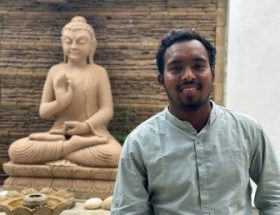Kangsa Manlong
After an Assam grass-roots language revival effort known as ‘Learn Ahom’ gained attention, digital commentator Aboyob Bhuyan and his platform The Truth India launched a furious counter-attack. In his usual third-person bombastic style, Bhuyan has repeatedly named Learn Ahom as “anti-Assamese” or even “pro-Pakistan,” accusing the project of fomenting communal division. In reality, Learn Ahom is a genuine cultural initiative – part of a long tradition of Ahom language revival dating back a century– aimed at promoting Assam’s indigenous Tai-Ahom heritage. The Tai-Ahom people once spoke this language as their sole tongue before the 1st century. Today, Learn Ahom provides free lessons and even a digital font to help new learners, a sincere effort to preserve language and culture, not a Trojan Horse. That made it a target for Bhuyan’s outrageously false narratives (for example, inventing a link between hate monger “Chwfa” and Learn Ahom with no basis).
Satirically speaking, The Truth India seems to believe that teaching Ahom words is somehow a threat to the nation. This is, of course, absurd. Experts note that statesman G. Barua and others have been documenting the revival of the Ahom language since the 1920s. Preserving a minority language is an unremarkable patriotic duty in a democracy. An academic study of Assam’s Tai-Ahom heritage observes that even UNESCO-recognized sites in Assam promote Tai-Ahom language and rituals as a valuable cultural legacy. Learn Ahom’s volunteers and students are carrying forward that tradition; they are restoring ancestral scripts and histories, not undermining Assam. But in Bhuyan’s cartoonish worldview, any defense of indigenous culture is rebranded as sedition.
Key Allegations: Aboyob Bhuyan and The Truth India have leveled all sorts of wild charges at Learn Ahom and similar efforts, including: attacking grassroots heritage projects as “anti-Assamese,” peddling false social media fables (the made-up anti nationalist “Chwfa” that is probably run by Aboyab and team themselves to smear the name of “learnahom”), trying to recast Assam’s fairs and customs as strictly Hindu rites, and stamping anyone who criticizes military or political abuses as an “anti-national.” The accusations read like a bulleted list from a far-right checklist. In reality, these charges are baseless fabrications.
Patriotism Means Critique, Not Blind Loyalty
One of Bhuyan’s favorite tropes is to frame any dissent, especially questioning the army or state narratives, as “anti-national.” This view is backwards. In a true democracy, speaking out against injustice is patriotism, not treason. As one commentator dryly noted, “to speak against injustice and to voice one’s opinion…should not automatically be stamped with ‘anti-nationalism’”. In Golaghat, even a casual online comment criticizing some events got an Assam woman detained for “anti-national comments”. These incidents illustrate Bhuyan’s double standard: criticism of power is vilified, while defending rights and victims is deemed unpatriotic.
By contrast, true patriotism is about holding one’s country to its highest ideals. History shows that blind obedience is the real betrayal. The Washington Post and other outlets document longstanding issues like Army abuses in the Northeast, from extrajudicial killings to sexual violence. In Manipur’s Thangjam Manorama case (2004), a female villager was tortured and killed by Assam Rifles, sparking mass protests. In 1987, Nagaland saw “Operation Bluebird,” during which tribal women were raped by security forces. These are documented atrocities. Is demanding accountability for such crimes “anti-national”? Or is silence a greater affront to India’s soul? Bhuyan, of course, ignores these truths. He wants a version of patriotism that refuses to see any fault in authority. But as James Baldwin famously said (in another context), “I love [my country] more than any other…and, exactly for this reason, I insist on the right to criticize her perpetually”. In that spirit, many Assamese see courageous dissent as the duty of a good citizen, not something to be punished. Has Bhuyan ever questioned how 13 innocent people were butchered by the Indian army in Oting? No, because he is an anti nationalist. A true patriot will hold the army of his country accountable.
Proud Patriots, No Self-Appointed Gatekeepers
It is rich for Bhuyan and The Truth India to lecture others on loyalty. Northeast India has long served India with pride, from soldiers in every conflict to activists preserving heritage. People here defend the nation daily; they don’t need thumbs-up from outsiders. Aboyob Bhuyan’s sneering implication that Assamese or Ahom activists are somehow less Indian is offensive to the region’s genuine patriots. The youth of Assam remember their own heroes – many of whom wore the Indian uniform – and do not need validation from social-media demagogues. Indeed, a grassroots activist once pointed out that those who defend rape, genocide or cultural erasure (even implicitly) would be far more rightly called “anti-national” than anyone who cultivates a mother tongue or protests injustice.
Northeasterners, in fact, often criticize this version of nationalism. They see that real love for India means protecting its unity in diversity, not erasing every regional difference in one giant stamp. For instance, why should Assam’s proud Ahom culture be flattened to fit a narrow Hindu template? Why should a vibrant spring harvest festival be relabeled as a Vedic rite? The more moderate Assamese ask: Is it “un-Indian” to ask such questions, or is it only un-Indian to suppress them?
The Chwfa Case
In late April 2025, Assam’s social media buzzed with talk of an Instagram handle “chwfa” posting inflammatory content, from celebrating the Pahalgam terror attack to anti-Assamese memes like “Assamese ❌, Bihari ✓.” The BJP-led state government promptly launched a ‘crackdown on anti-India remarks” after the Pahalgam attack. This is perfectly valid and must be done, but what is concerning is that Bhuyan and team are using this to target innocent people who are working for their community.
Local posts suggest “Chwfa” was swept up in this purge, but in fact, no official report names it explicitly. In short, beyond social-media chatter, there is no confirmed information on who runs @chwfa or even if it’s one real person. Contrast this with learnahom.
Learn Ahom is a well-known grassroots cultural project with a purely educational focus. Its website and social accounts are full of Ahom alphabet, Tai-Ahom language lessons, and historical notes – no political or religious ranting. For example, LearnAhom.com’s homepage proudly offers “the consonants and vowels of the Ahom language,” short grammar lessons, and even an English–Ahom translator tool. There is no hint of anti-Hindu or anti-India ideology on its pages. All content is about teaching the ancient Tai-Ahom script and culture – exactly what a cultural revival initiative should be doing. To date, Learn Ahom’s published work is uniformly cultural, consistent with its mission. In other words, the idea that a serious language-revival NGO would secretly run a bait-and-switch “anti-India” account is extremely implausible given its track record.
Hindutva Homogenization: The Real Threat
Bhuyan’s chatter about “true Assam” often slides into an unspoken agenda: assimilate the Northeast into a monolithic vision of India. In practice, that means pushing a Hindu-majoritarian narrative and favoring new settlers over indigenous populations. Already under BJP rule, Assam experienced shocks like the NRC and CAA, which many locals view as attempts to legitimize incoming “Bengali Hindus” over Assam’s tribal communities. One scholar notes that in Tripura, for example, Bengali Hindus now outnumber the indigenous Tripuri people, leading to fierce opposition because the new laws would cement that demographic change. Put simply, the Citizenship Amendment Act is widely seen in the Northeast as anti-indigenous (not just anti-Muslim). Unsurprisingly, many fear Mr. Bhuyan’s echoes of “one nation, one religion, one language” rhetoric– because India’s strength has always come from pluralism, not forced unity.
In one revealing episode (the 2023 Sivasagar protests), local Assamese “patriot” groups even turned on out-of-state Hindus (Marwaris and Biharis) as outsiders, only to have the state minister sharply redirect the anger toward Bangladeshi-origin Muslim migrants instead. This shows the flimsy logic: “first attack any non-Assamese, then we’ll tell you whom to really hate.” Critics of Bhuyan argue that he and his ilk exploit such fears to push a Hindutva agenda under the guise of “protecting Assam.” In reality, this is mere cultural imperialism. As a scholar aptly put it, forcing everyone into a single religion or culture (a project obvious in recent policy debates) is not defending India’s spirit but betraying it. Indeed, long-time analysts warn that Hindutva’s goal of “one nation, one language, one religion” would destroy the very diversity that makes India, well, India. So remember the following:
- Those like Bhuyan who champion gang-rape of tribal women or ethnic cleansing and then clothe it in nationalist rhetoric – they, ironically, are the true enemies of the nation.
- The Northeast remembers our martyrs and heroes; we don’t need preachy strangers to define our patriotism.
- As scholars note, attempts to impose purely “Hindu” labels on a multicultural festival like Bihu are political tricks, not scholarship
Bihu and the Battle Over Tradition
Northeast communities dancing Bohag Bihu: a spring harvest celebration that transcends religion, not a “Hindu” ritual. In Assam, each April, folk dancers in gamosas and dhotis celebrate Bohag Bihu, the Assamese New Year. For some media pundits, however, this became another front in the culture war: a recent Swarajya piece, echoed by social-media voices, insisted Bihu must be “reclaimed” as a “Hindu spiritual” festival. Local experts rolled their eyes. As NorthEast Now reports, Bihu predates any Vedic overlay – it came from diverse tribal farming cycles, and Assam’s tribes have their own spring festivals by other names. In short, Bihu is an agrarian tribal festival, not a sectarian one. As Bihu scholar Hema Gogoi puts it, “there is no scope for a second opinion: Bihu is a tribal agrarian festival, not a religious one.”
Bhuyan’s camp demanded we “bring back Bihu’s dharmic roots” – effectively claiming that generations of Assamese had somehow lost their Hinduism – but every Assamese child knows the truth on the ground. Bihu drums never cared about caste or creed. The moment this distortion surfaced, Assamese commentators blasted it as a blatant Hindutva propaganda attempt, after all, changing festivals’ origins to suit political ends is a classic play – and a sad betrayal of our heritage. The Truth India appears to have jumped into this fray, eager to outrage its audience, painting every shared cultural feast as yet another sign of Hindu conspiracy.
In sum, Aboyob Bhuyan’s Truth India campaign against Learn Ahom and Assamese diversity is neither honest nor patriotic. It recycles every tired trope – “us vs. them”, one-nation-one-faith, and ‘dissent=treason’ – as if Assam had never marched in its own historical parade. But Assam has a long history of plural faiths and languages; its beauty lies in that variety. India’s soul is woven from many strands: linguistic, ethnic, religious, and tribal. To forcibly homogenize it is to betray every ideal of the republic. While Bhuyan rails against language activists and festival revivers as “anti-national”, it’s worth asking: who are the real patriots? Are they the bureaucrats who ensure Northeast voices are heard? Or the loudmouths who parrot oversimplified nationalism? The answer should be obvious. Those who defend violence, erase communities, or weaponize identity are the true enemies of India’s unity. The rest of us – farmers and teachers, and students in Assam, Arunachal, Manipur, and beyond – will keep honoring the land’s heritage in our own way. We love India enough to question her, and we pride ourselves on protecting its diverse spirit, come what may. In that regard, Aboyob Bhuyan and his clique are not protecting the nation – they are undermining it by peddling fear and falsehood, betraying the very diversity that makes India strong.
~~~
Kangsa Manlong, is a civil engineering student from the Tai Khamti Community of Arunachal. He adheres to the Theravada sect of Buddhism. He strongly believes in Tai unification and speaks nine languages fluently: Khamti, Dai, Thai, Laotian, Khmer, Shan, Assamese, Hindi, and English.










